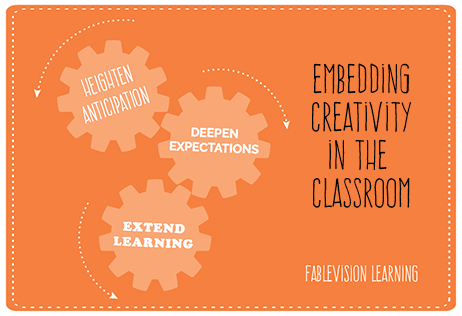Embedding Creativity in the Classroom
Is This YOUR Year of Creativity?
It is our hope that classrooms are places brimming with creativity - with new and interesting ideas that spark students' motivation, love of learning, and ability to uniquely express who they are and what they know.
While sometimes it seems like creativity and the work of school are separate matters, the truth is that students learn best, and more deeply when information is presented creatively. In fact, there is a researched based method for incorporating creative thinking skills into the classroom.
Being able to see things in different ways and from different perspectives, imagining possibilities, making connections between unexpected concepts, and breaking through the “usual” way to discover alternatives are all creative skills that strengthen students’ understanding and set them up for creating a better future.
The Torrance Incubation Model, developed by psychologist E. Paul Torrance, incorporates these creativity skills into any lesson in any subject to enliven lessons and develop creative thinking in students (and teachers!). We have begun using this model to help teachers ignite creativity in their classrooms and make meaningful lessons that lead to deep learning.
In this model, a teacher weaves a creative skill into three parts of a lesson. The first part is heightening anticipation to get the students curious and excited. Perhaps in introducing the skill “Look at it Another Way” the students are presented with this image. What is it? How does it make you feel? Can you look at it another way and see something else? This creativity skill is then incorporated into the content, for example, of learning the elements of a story.
We do this in the next part, deepening expectations, by working with the content in a more thorough way while still practicing the creativity skill. This is when we dig into what the elements of a story are and what purpose they serve. While we do this, we can look at the story another way, like through the perspective of the villain. From this perspective, do the story elements change? There is a lot to explore this way, and the teacher can guide the class through analysis.
Finally, we must give the students the opportunity to use what they know outside of the context of the lesson. This is called extending the learning. The teacher may give the students the opportunity to retell, rewrite, or continue their favorite story from the perspective of the villain, demonstrating their understanding of story elements and how they move a story along.
Once we’ve journeyed through these three levels of a lesson and incorporated a creative thinking skill, the students’ minds are primed for incubation, which means they’ll hold onto the information longer and will be more ready to use it in any context to which they can connect it. They’ll also be better able to envision new ways to use and express what they know. Can you imagine the possibilities?
We believe that everyone is creative and everyone has a spark inside them. Torrance’s model, along with the 18 creative skills he defines, brings learning to a whole new creative level. Teachers that want to learn more about fanning the spark in their students and making creativity part of their everyday lessons can join our cohort of teachers taking our Certified Creative Educator Course at www.thecreativitycircle.org.
Sara Smith is the Director of Creative Education at FableVision Learning. Sara is an experienced K-12 educator, creativity facilitator and curriculum designer. She is an amateur but enthusiastic ukulele player and improv actor. She earned her master's degree in creativity from SUNY College at Buffalo. Now she works with FableVision Learning to inspire creative thinking in teachers and students through professional development and joyful learning experiences. She lives in Charlotte, NC, where she can happily and unabashedly use the word y'all.
CITATIONS
The Torrance Incubation Model can be found detailed in Torrance, E. P., & Safter, H. T. (1990). The incubation model of teaching: Getting beyond the Aha! Buffalo: Bearly Limited.



